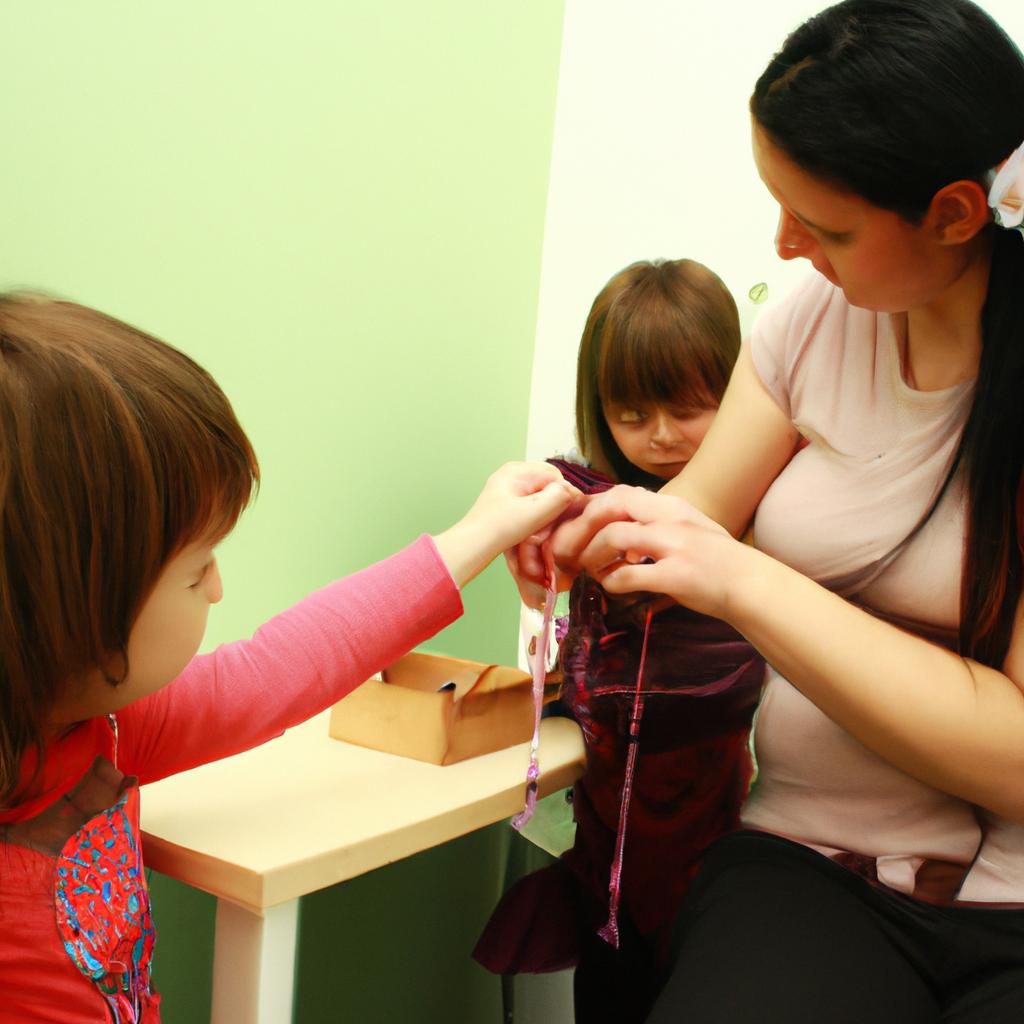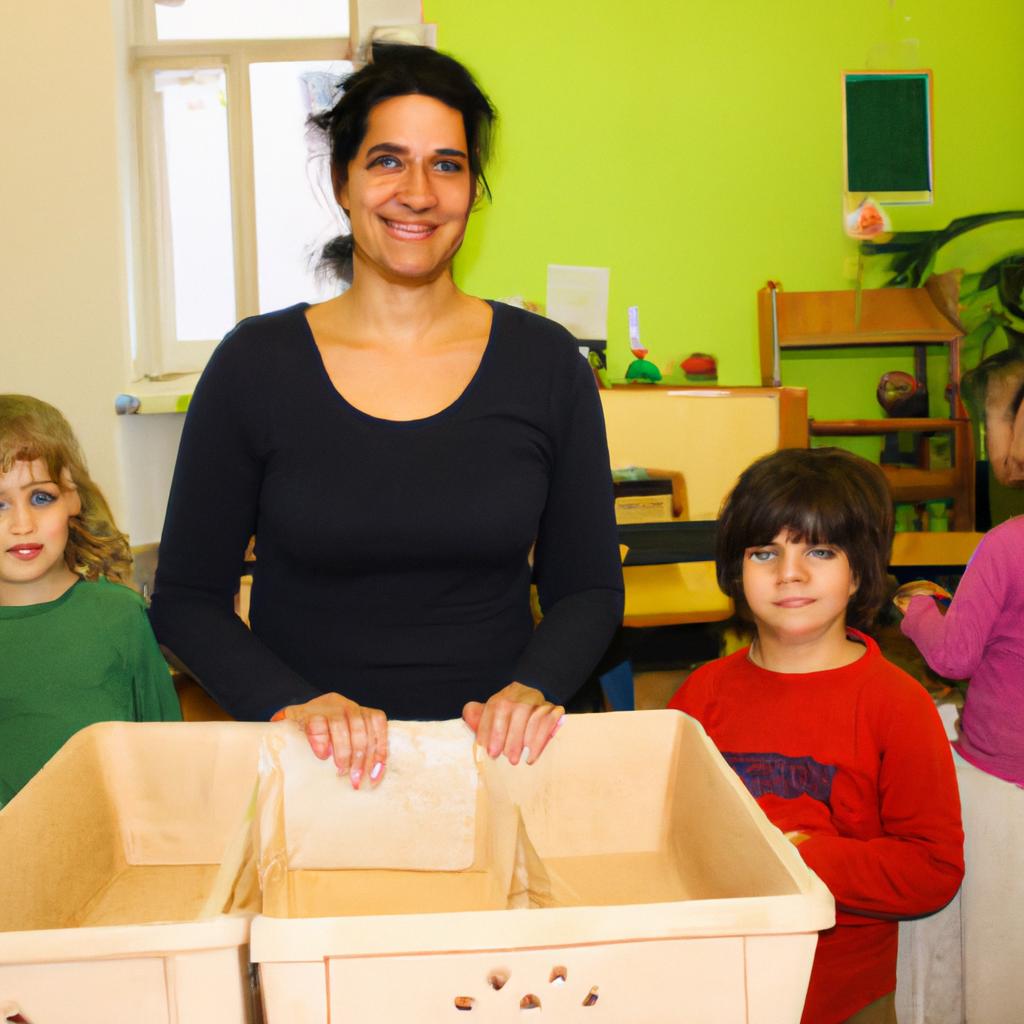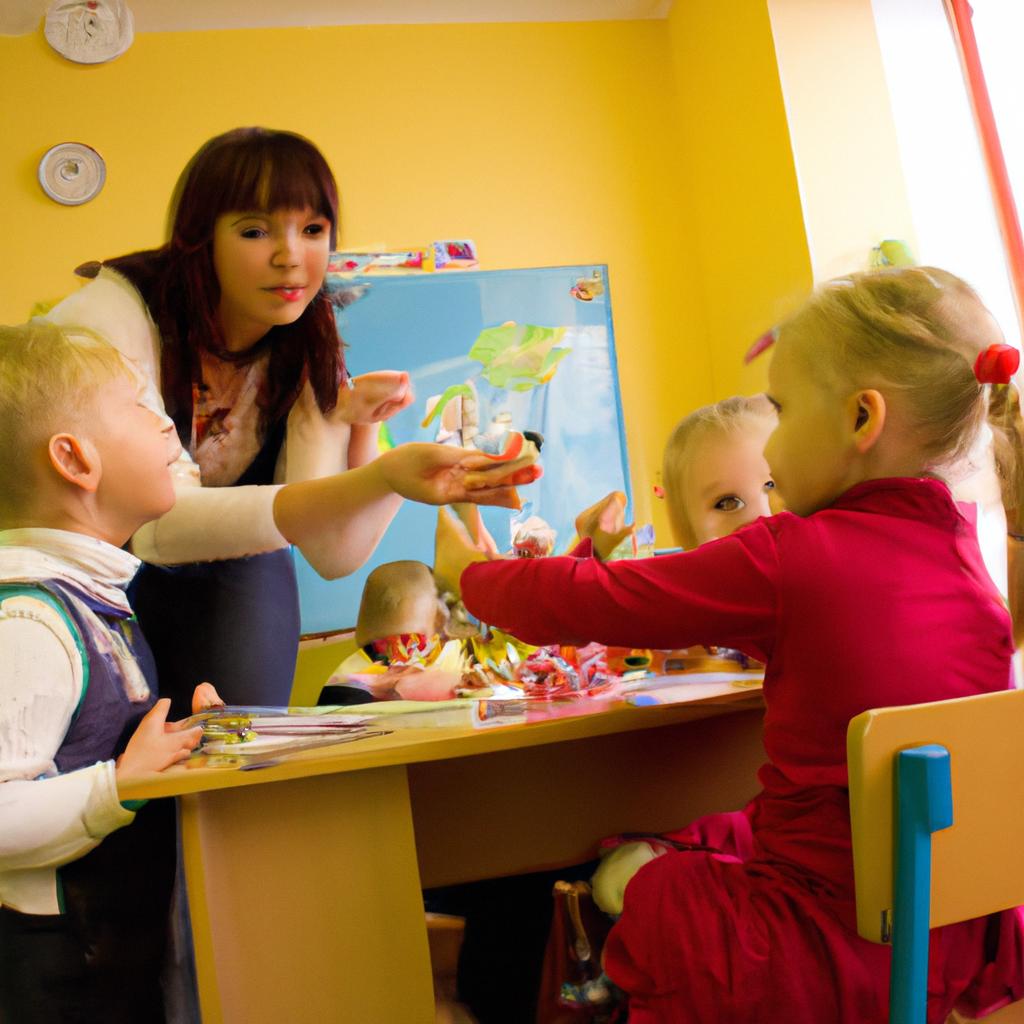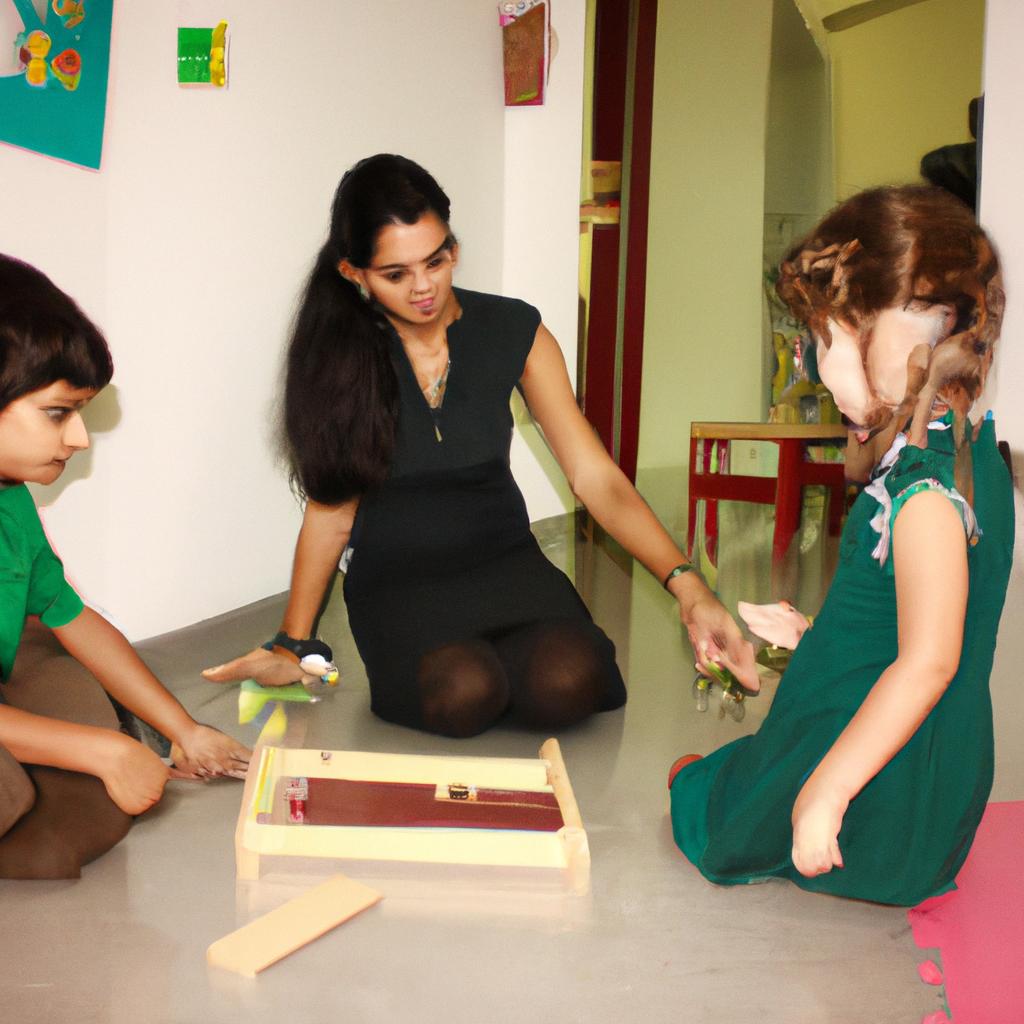In recent years, there has been a growing interest in implementing Montessori principles within the traditional school setting. The Montessori approach is centered around promoting freedom with responsibility, allowing students to have more autonomy and control over their learning process. This article aims to explore the benefits and challenges of incorporating Montessori principles in a school environment, drawing upon both theoretical frameworks and practical examples.
One hypothetical case study that exemplifies the potential impact of implementing Montessori principles can be seen in a middle school classroom where students are given the opportunity to choose their own projects based on their individual interests and abilities. In this scenario, instead of following a rigid curriculum, students are encouraged to engage in self-directed learning experiences. As a result, they become active participants in constructing knowledge and develop vital skills such as problem-solving, critical thinking, and time management. By providing an environment that fosters independence and personal growth, the implementation of Montessori principles can transform classrooms into dynamic spaces that empower students to take ownership of their education.
While the concept of freedom with responsibility may sound appealing in theory, its successful implementation poses certain challenges within a traditional school framework. One major obstacle lies in finding balance between ensuring academic rigor while also allowing for flexibility and student choice. Additionally , teachers may require additional training and support to effectively implement Montessori principles in their classrooms. This includes understanding the philosophy behind the approach, adapting instructional strategies, and creating an environment that supports student autonomy.
Another challenge is overcoming resistance from various stakeholders, including parents, administrators, and policymakers. Some may question the effectiveness of a non-traditional approach and express concerns about academic outcomes or standardized testing. It is important to address these concerns through research-based evidence and clear communication about the benefits of incorporating Montessori principles.
Furthermore, implementing Montessori principles within a traditional school setting may require adjustments to existing infrastructure and resources. For example, classrooms may need to be reorganized to facilitate independent workstations or provide materials that promote hands-on learning experiences. Schools may also need to allocate time for individualized instruction and assessment.
In conclusion, incorporating Montessori principles within a traditional school setting can offer numerous benefits for students, such as fostering independence, critical thinking skills, and personal growth. However, it also presents challenges related to maintaining academic rigor while allowing for flexibility, providing necessary training and support for teachers, addressing stakeholder concerns, and allocating appropriate resources. By carefully considering these factors and making informed decisions, schools can create a learning environment that combines the best elements of both approaches.
Understanding the Montessori philosophy
The Montessori educational approach, developed by Dr. Maria Montessori in the early 20th century, is based on the belief that children have an innate desire to learn and explore their environment. This philosophy emphasizes freedom within limits, allowing students to develop independence and self-discipline while also nurturing their natural curiosity. One example of how this philosophy can be implemented is through the use of mixed-age classrooms where older students serve as mentors for younger ones, creating a collaborative learning environment.
To gain a deeper understanding of the Montessori philosophy, it is important to consider its key principles:
-
Individualized Learning: In a Montessori setting, each student’s unique strengths and interests are acknowledged and supported. The curriculum is flexible and personalized to meet the needs of every learner, enabling them to progress at their own pace.
-
Prepared Environment: A well-designed classroom plays a crucial role in facilitating learning experiences. The physical space should offer various hands-on materials that encourage exploration and discovery. Additionally, it should promote orderliness and provide opportunities for developing practical life skills.
-
Freedom with Responsibility: While students are given freedom to choose activities that interest them, they are also taught to respect the boundaries set by the teacher and community. Through this balance between autonomy and responsibility, children learn self-control and develop social skills.
-
Holistic Development: The Montessori approach recognizes that education goes beyond academics; it encompasses emotional, social, physical, and cognitive development. By focusing on these aspects holistically, educators aim to nurture well-rounded individuals who possess empathy, resilience, critical thinking skills, and creativity.
By embracing these principles within an educational framework inspired by Dr. Maria Montessori’s teachings, schools can create an environment conducive to fostering independent thinkers who take ownership of their learning journey.
Creating a prepared environment for learning involves careful consideration of classroom design elements that support active engagement and exploration.
Creating a prepared environment for learning
Understanding the Montessori philosophy is crucial to implementing its principles effectively in a school setting. By embracing this approach, educators can create an environment that nurtures independence and self-discipline among students. One example of how this philosophy translates into practice is seen in the case study of Maple Elementary School.
Maple Elementary implemented a Montessori-inspired curriculum, focusing on hands-on learning experiences and individualized instruction. The teachers observed remarkable changes in student behavior and engagement after adopting these principles. Students became more responsible for their own learning, actively seeking out materials and activities that interested them. This shift led to improved academic performance and a greater sense of ownership over their education.
To successfully implement Montessori principles, several key factors need to be considered:
-
Prepared Environment: Creating a well-organized classroom with carefully arranged materials allows students to explore their interests independently. A prepared environment should include age-appropriate resources that foster curiosity and facilitate self-directed learning.
-
Freedom within Limits: Granting students freedom to choose their activities while establishing clear boundaries helps develop responsibility. Students learn to make decisions within established guidelines, promoting self-regulation and respect for others.
-
Mixed-Age Groupings: Encouraging interaction between different age groups fosters collaboration, empathy, and mentorship opportunities among students. Older children serve as role models for younger peers, while younger children benefit from exposure to more advanced concepts.
-
Teacher as Facilitator: In a Montessori-inspired setting, the teacher’s role shifts from traditional instruction to guiding students’ learning journeys. Teachers observe each child closely, providing support when needed while allowing space for independent exploration.
The emotional impact of implementing Montessori principles is evident through the positive transformation experienced by both students and educators alike. To illustrate this further:
| Positive Effects of Montessori Implementation |
|---|
| Improved student motivation |
| Greater sense of responsibility |
In conclusion, by understanding the Montessori philosophy and implementing its principles in a school setting, educators can create an environment that promotes independence and self-discipline. The case study of Maple Elementary School demonstrates how these principles positively impact student behavior and engagement. By creating a prepared environment, allowing freedom within limits, utilizing mixed-age groupings, and adopting a facilitator role as teachers, schools can empower students to take ownership of their learning journey.
Fostering independence and self-discipline
Building upon the foundation of a prepared environment, fostering independence and self-discipline is another crucial aspect of implementing Montessori principles in a school setting. By empowering students to take ownership of their learning process and instilling a sense of responsibility, educators can create an environment that promotes personal growth and development.
Fostering independence begins with providing students opportunities to make choices within structured limits. For instance, in a Montessori classroom, children are encouraged to select their own work activities from various shelves filled with materials designed for different developmental stages. This not only allows them to explore their interests but also cultivates decision-making skills and autonomy. Additionally, incorporating real-life tasks into the curriculum, such as practical life exercises like pouring water or arranging flowers, further enhances independence by teaching students essential skills they can apply outside the classroom.
To develop self-discipline, it is essential to establish clear expectations and consistently enforce boundaries. Creating a positive classroom culture where respect for oneself and others is emphasized helps foster self-control and responsible behavior among students. Teachers can use strategies such as modeling appropriate behaviors, providing gentle reminders when necessary, and offering praise for demonstrating self-discipline. Furthermore, involving students in creating classroom rules through open discussions encourages them to take ownership of their actions while promoting a sense of community.
Incorporating emotional intelligence education plays a vital role in fostering independence and self-discipline in young learners. Teaching children how to recognize and manage their emotions equips them with valuable skills that contribute to healthy social interactions and effective problem-solving. By prioritizing empathy training alongside academic instruction, schools enable students to develop stronger interpersonal connections while enhancing their ability to navigate conflicts constructively.
| Benefits of Fostering Independence | ||
|---|---|---|
| 1. Encourages critical thinking | 2. Builds resilience | 3. Promotes creativity |
| 4. Cultivates self-confidence |
Promoting independence and self-discipline in students creates a strong foundation for academic success, personal growth, and overall well-being. By empowering learners to take charge of their learning journey, educators instill invaluable life skills that extend beyond the classroom. In the subsequent section about “Promoting hands-on learning experiences,” we will explore how incorporating interactive activities can enhance student engagement and deepen understanding.
Promoting hands-on learning experiences
Transitioning from the previous section that focused on fostering independence and self-discipline, this next section delves into the importance of promoting hands-on learning experiences in a Montessori school setting. By providing students with opportunities to actively engage in their own education, these experiences encourage curiosity, critical thinking, and problem-solving skills.
To illustrate the significance of hands-on learning, let us consider an example: Imagine a group of preschoolers exploring a nature corner within their classroom. Equipped with magnifying glasses and specimen jars, they eagerly collect leaves, rocks, and insects while observing them closely. Through direct interaction with the natural world, these young learners develop not only scientific knowledge but also emotional connections to nature. This active exploration ignites their sense of wonderment and inspires further investigation.
Hands-on learning experiences offer numerous benefits for students in a Montessori school setting:
- Engagement: When children are involved in hands-on activities, they become fully engaged in the learning process. They are more likely to retain information and exhibit higher levels of motivation.
- Problem-solving: Hands-on activities often require students to think critically and solve problems independently or collaboratively. These experiences cultivate analytical skills as well as creativity.
- Social interaction: Collaborative projects or experiments promote teamwork and communication among students. Working together enhances social skills such as leadership, empathy, and cooperation.
- Multisensory stimulation: Hands-on activities incorporate various senses like touch, sight, smell, and even taste when appropriate. Engaging multiple senses simultaneously helps reinforce understanding and memory retention.
| Benefits of Hands-On Learning |
|---|
| Engagement |
| Problem-Solving |
| Social Interaction |
| Multisensory Stimulation |
Incorporating hands-on learning experiences into a Montessori school setting creates an environment that nurtures curiosity and fosters a love for learning. By actively engaging with materials and concepts, students develop essential skills while also cultivating their interests and passions. This approach sets the foundation for lifelong learning as it encourages self-directed exploration and discovery.
Transitioning into the subsequent section about incorporating mixed-age classrooms, we will explore how this dynamic arrangement further enhances the Montessori educational experience.
Incorporating mixed-age classrooms
Building on the success of promoting hands-on learning experiences, another crucial aspect of implementing Montessori principles in a school setting is incorporating mixed-age classrooms. This approach fosters collaboration and encourages children to learn from one another, creating an environment that embraces diversity and promotes holistic development.
In a hypothetical case study, let’s consider a primary classroom where students aged 3-6 years old are grouped together. The younger ones observe and learn from their older peers, while the older children reinforce their knowledge by teaching concepts they have already mastered. This dynamic interaction not only enhances academic growth but also nurtures social skills such as empathy, cooperation, and patience.
To further emphasize the benefits of mixed-age classrooms, we can highlight the following emotional response-evoking bullet points:
- Encourages peer mentoring and leadership qualities
- Fosters a sense of belonging and community
- Creates opportunities for personalization of learning experiences
- Promotes independence and individual responsibility
Table: Benefits of Mixed-Age Classrooms
| Benefit | Description |
|---|---|
| Peer Mentoring | Older students serve as mentors for younger ones, fostering positive relationships and providing guidance |
| Sense of Belonging | Students develop stronger connections with classmates across different age groups, leading to increased feelings of inclusion |
| Personalized Learning | Teachers can tailor instruction based on each student’s unique needs and abilities within the mixed-age classroom environment |
| Independence & Responsibility | Younger students observe older peers taking on responsibilities independently, inspiring them to be more self-sufficient |
As educators embrace this approach in their classrooms, it is important to recognize that mixing ages alone may not automatically result in harmonious learning environments. Proper planning and support mechanisms must be in place to ensure successful implementation. By offering engaging activities tailored to various skill levels and interests, teachers provide an inclusive space where students can thrive academically and socially.
Building on the foundations of promoting hands-on learning experiences and incorporating mixed-age classrooms, another key aspect of implementing Montessori principles is encouraging freedom within limits. This approach allows children to develop autonomy while also teaching them responsibility and respect for boundaries.
Encouraging freedom within limits
Building upon the success of incorporating mixed-age classrooms, another essential aspect of implementing Montessori principles in a school setting is encouraging freedom within limits. By providing students with opportunities to make choices and take ownership of their learning, while also establishing boundaries for responsible behavior, schools can create an environment that fosters independence, self-discipline, and academic growth.
One example of promoting freedom within limits is allowing students to select their own work activities from a carefully prepared environment. For instance, a hypothetical scenario could involve a primary classroom where children have the option to choose among different math materials such as counting beads or number rods. This autonomy not only empowers students but also allows them to follow their individual interests and progress at their own pace.
To effectively encourage freedom within limits, educators can implement strategies that support student decision-making while maintaining structure. Consider the following bullet points:
- Provide clear guidelines on acceptable behaviors and expectations.
- Foster open communication channels between teachers and students for problem-solving and conflict resolution.
- Offer regular opportunities for reflection and goal-setting to help students develop self-awareness and self-regulation skills.
- Create a supportive community by involving parents in understanding the importance of balancing freedom and responsibility.
Furthermore, it is important to recognize that striking this balance requires careful planning and ongoing assessment. The table below illustrates some key considerations when implementing freedom within limits in a Montessori-inspired school setting:
| Key Considerations | Benefits | Challenges |
|---|---|---|
| Individualized | Encourages intrinsic motivation | Requires differentiated |
| Instruction | Supports diverse learning styles | instruction approaches |
| Student Autonomy | Fosters critical thinking | May require additional teacher |
| Promotes problem-solving skills | facilitation/support |
By embracing these ideas, educators can empower students to become independent learners who are capable of making informed decisions while respecting boundaries. This approach not only cultivates a sense of responsibility but also equips students with crucial life skills that extend beyond the school environment.
In conclusion, implementing Montessori principles in a school setting involves recognizing the importance of encouraging freedom within limits. By allowing students to choose their activities and take ownership of their learning journey while establishing clear boundaries, schools can create an environment that supports independence, self-discipline, and academic growth. Through careful planning and ongoing assessment, educators can strike a balance between autonomy and responsibility, fostering student development and preparing them for success both inside and outside the classroom.










